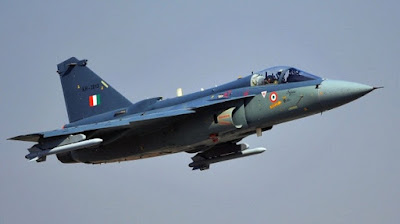Tejas Mk1 in action.
Should
HAL boost production of Tejas Mk-1 & Mk-1A?
By:- Kartikeya Semwal
Now that we all know that by the end of 2019,
IAF will be down to just 30-32 squadrons as against the sanctioned strength of
42; it’s high time that the Govt. of India (GOI) & HAL should focus on
addressing the issue of falling fighter squadrons of Indian Air-Force (IAF).
HAL that has been tasked with producing the indigenous LCA (Light Combat
Aircraft) Tejas Mk-1 & 1A has just produced 16 of the first 40 Tejas Mk-1s.
So ironically, HAL has failed to produce even 1 full squadron of Tejas jets
despite passage of 1 & ½ years which is very slow.
While our threatening neighbours Pakistan & China are adding new fighters in considerable numbers every year. The latest
news about Pakistan was that, it would start getting JF-17 block-III from
July-August this year. Similarly, China too is adding J-20 5th
generation fighters at a good pace while India lags behind in this race. Now
HAL says that it isn’t easy to produce Tejas Mk-1 and later Mk-1As as the first
one has to be built from scrap while the 2nd one is much different
in terms of parts, engines & aerodynamics, etc. HAL also blames lack of
proper infrastructure to produce the Tejas jets at a faster pace.
Now my question is-“who is stopping you (HAL) to
upgrade & increase your production capacities?” Another point to be noted
is- “when you (HAL) know that you can’t produce the jets faster on your own,
then why not take help of some private Indian firms such as Tata & Mahindra,
both of who have the infrastructure & required skilled manpower.” These are
the 2 questions that GOI should be asking HAL & ensure that HAL delivers 16-18
fighters to IAF every year.
MWF Concept model.
Tejas Mk-1 is a good 4th+ gen. fighter
while Mk-1A is even better. I’m now going to provide you with details of Tejas
Mk-1A regarding how is it better & more potent Mk1. Tejas Mk-1A has the
following upgrades that are lacking in Mk-1:-
1. Indigenous Uttam AESA Radar co-developed with Israel’s ELTA corp.
2. More modern Avionics with improved design & S-shaped wind tunnels.
3. Aircraft’s weight reduced by 1000 kg from its initial weight of 6500 kg.
4. Made maintenance friendly by re-configuring some of its LRUs and proper distribution of the dead weight in the aircraft.
5. In-flight refuelling capability & on-board Oxygen Generation System.
6. Integrated electro-optic Electronic Warfare (EW) sensor.
7. Integration of BVRs like Astra and Derby (I, II) with short & medium range.
8. Integration of Aircraft Parachutes at the back to help the pilot to land the aircraft safely if it’s brakes fail.
9. DRDO (Defence Research & Development Organization) and GOI are also in talks with Israeli defence firm Rafael Advanced Defense Systems, to acquire the most modern version of Derby-III BVR missiles (under development) which have the range of 60-90 km.
10. Homegrown dry-thrust Kaveri engine which on completion, will be fitted to Mk1-A variants. Kaveri Engine will have thrust equivalent to America’s GE414 engine and will be fitted to 2D TVC thrust vectoring nozzles.
11. Self-protection electronic jammer & decoy chaffs to confuse & divert enemy missiles & rockets.
Now let’s get
back to HAL as to why should they boost production of Tejas jets. I’ve already
mentioned about the shortage of fighters in IAF so let’s move on to other
things. A total of 40 Tejas Mk-1 & 83 Mk-1As are to be delivered to IAF by
2025 but I strongly believe that going by the number of fighter-jet induction
of our dangerous neighbours, HAL should try to deliver all Tejas jets by
2022-23. Coz in case of a two-front war, India will be fighting on 2 fronts
which is going to be very tough; thanks to just 30-32 squadrons of IAF. If HAL
succeeds to do so, then by 2022-23, IAF could have as many as 38-40 squadrons
which is much better then 30-32.





Excellent article. Well researched and well presented.
ReplyDeleteVery well written. Good job. 👍🏻
ReplyDelete